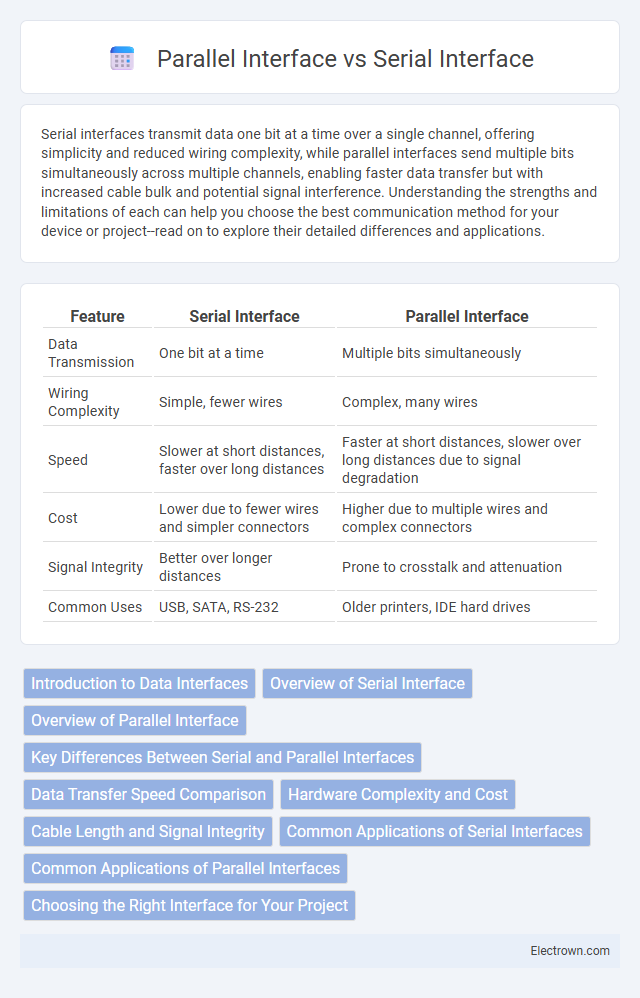Serial interfaces transmit data one bit at a time over a single channel, offering simplicity and reduced wiring complexity, while parallel interfaces send multiple bits simultaneously across multiple channels, enabling faster data transfer but with increased cable bulk and potential signal interference. Understanding the strengths and limitations of each can help you choose the best communication method for your device or project--read on to explore their detailed differences and applications.
Table of Comparison
| Feature | Serial Interface | Parallel Interface |
|---|---|---|
| Data Transmission | One bit at a time | Multiple bits simultaneously |
| Wiring Complexity | Simple, fewer wires | Complex, many wires |
| Speed | Slower at short distances, faster over long distances | Faster at short distances, slower over long distances due to signal degradation |
| Cost | Lower due to fewer wires and simpler connectors | Higher due to multiple wires and complex connectors |
| Signal Integrity | Better over longer distances | Prone to crosstalk and attenuation |
| Common Uses | USB, SATA, RS-232 | Older printers, IDE hard drives |
Introduction to Data Interfaces
Serial interfaces transmit data one bit at a time over a single channel, optimizing for long-distance communication with reduced signal degradation. Parallel interfaces send multiple bits simultaneously across multiple channels, offering faster data transfer rates ideal for short-distance communication due to minimized timing skew. Both data interfaces serve critical roles in hardware design, influencing system performance, complexity, and application suitability.
Overview of Serial Interface
Serial interface transmits data one bit at a time over a single communication channel, enabling simpler wiring and longer cable lengths compared to parallel interfaces. It is commonly used in communication protocols such as UART, SPI, and USB, offering reduced signal interference and cost efficiency. The serial interface's point-to-point data transfer supports high-speed communication in modern computing and networking applications.
Overview of Parallel Interface
A parallel interface transmits multiple bits simultaneously across multiple channels, enabling faster data transfer rates compared to serial interfaces for short distances. It is commonly used in computer memory, printers, and older data communication applications where speed outweighs cable complexity. Your system benefits from parallel interfaces when high-speed, short-distance communication is critical for optimum performance.
Key Differences Between Serial and Parallel Interfaces
Serial interfaces transmit data one bit at a time over a single channel, enabling longer cable lengths and reduced electromagnetic interference, while parallel interfaces send multiple bits simultaneously across multiple channels, offering faster data rates over short distances but suffering from signal degradation and crosstalk. Parallel interfaces require more wiring and pins, increasing complexity and cost, whereas serial interfaces utilize fewer lines, simplifying connections and enhancing reliability. Examples include USB and SATA for serial interfaces, and older printer ports and IDE for parallel interfaces, highlighting their typical applications and technological evolution.
Data Transfer Speed Comparison
Serial interfaces transmit data one bit at a time, resulting in lower data transfer speeds compared to parallel interfaces that send multiple bits simultaneously over multiple channels. Parallel interfaces often achieve higher throughput, especially in short-distance communications, due to simultaneous data transmission across multiple lines. Your choice depends on factors like distance and electromagnetic interference, with serial interfaces favored for long-distance high-speed communication despite slightly lower raw data transfer rates.
Hardware Complexity and Cost
Serial interfaces require fewer physical connections, reducing hardware complexity and lowering manufacturing costs compared to parallel interfaces, which involve multiple data lines and control signals. The simplified wiring in serial communication minimizes electromagnetic interference and crosstalk, enhancing signal integrity and further decreasing the need for expensive shielding. Parallel interfaces demand more PCB space and intricate connectors, increasing both complexity and overall production expenses.
Cable Length and Signal Integrity
Serial interfaces typically support longer cable lengths than parallel interfaces due to reduced signal degradation and lower electromagnetic interference. Parallel interfaces suffer from signal skew and crosstalk over longer distances because multiple data lines switch simultaneously. High-speed serial communication standards like USB and SATA maintain signal integrity with differential signaling, enabling reliable data transmission over extended cables.
Common Applications of Serial Interfaces
Serial interfaces are commonly used in applications requiring long-distance data transmission and reduced wiring complexity, such as USB connections for peripherals, SATA interfaces for storage devices, and communication protocols like RS-232 and RS-485 in industrial automation. Their ability to transmit data one bit at a time minimizes signal degradation and crosstalk, making them ideal for connecting devices like keyboards, mice, printers, and external hard drives. Your choice of interface impacts data transfer rates and system design, with serial interfaces favored in scenarios demanding reliability and cost-effectiveness.
Common Applications of Parallel Interfaces
Parallel interfaces are commonly used in applications requiring high-speed data transfer over short distances, such as connecting internal computer components like hard drives and printers. Industry-standard parallel interfaces, including IEEE 1284, are widely employed in legacy printer connections and embedded systems where multiple bits of data are transmitted simultaneously. Despite increasing adoption of serial interfaces in modern devices, parallel interfaces remain integral in manufacturing equipment and industrial automation due to their simplicity and robustness.
Choosing the Right Interface for Your Project
Selecting the right interface depends on data transfer speed requirements and cable complexity; serial interfaces offer slower transmission but simpler wiring and longer distances, while parallel interfaces provide faster data transfer at shorter distances with more complex cabling. Projects demanding high-speed communication and minimal interference benefit from parallel interfaces, whereas those prioritizing cost efficiency and longer cable runs favor serial interfaces. Evaluating project specifications such as bandwidth, distance, and electromagnetic interference helps determine whether a serial or parallel interface best aligns with the application needs.
Serial Interface vs Parallel Interface Infographic

 electrown.com
electrown.com